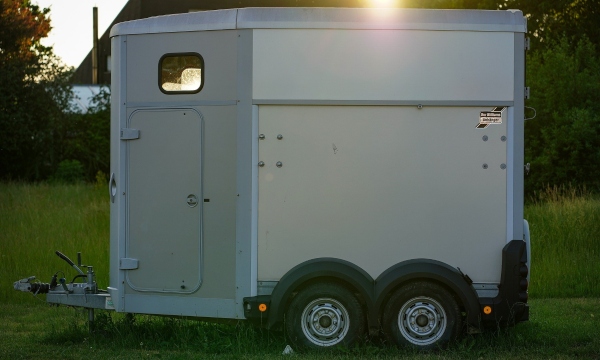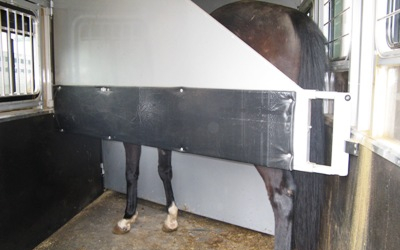We’ve already covered towing weights and shared insights into towing a caravan, so in this article, we’ll be looking at towing a horse trailer. While many things remain similar the addition of a live moving animal can add a new dynamic to towing.
Towing a Horse Trailer – The Law
So first things first, we’ve listed some of the laws you need to be aware of when towing a horse trailer. Luckily many of the same rules apply to towing a horse trailer as to towing generally.
Like any form of towing in the UK, it is important you hold the correct licence. If you passed your test prior to 1/1/97 you can drive a vehicle and trailer combination up to 8.25 tonnes maximum authorised mass (MAM).
People who passed their test post 1/1/97 face greater restrictions. They can drive a car or van up to 3,500kg MAM towing a trailer of up to 750kg MAM or tow a trailer over 750kg MAM, as long as the combined MAM of the trailer and the towing vehicle does not exceed 3,500kg. To tow anything heavier you must pass your B+E test.
Other laws you should be aware of:
- On a single carriageway maximum speed is 50mph.
- On dual carriageways or motorways the max speed is 60mph.
- You can’t travel in the outside lane of a three or more lane motorway when towing, unless there is a lane closure and you directed into.

Different Horse Trailers
There are a variety of different horse trailers available, but the most common variants in the UK are:
Single: lightweight trailer suitable for carrying just one horse. Depending on the overall weight it may be possible to tow on a Cat B licence.
Double: a larger trailer with the capacity to carry two horses which may include a separate area for carrying equipment.
Practice Makes Perfect
Due to the range of horse trailers available, it’s a good idea to familiarise yourself with your horse trailer. You should get to grips with the various mechanisms before you head off anywhere. You don’t want to find out on the day of an event you can’t secure the loading ramp fastening.
We also recommend practising towing the trailer unloaded to get a feel for how it tows before you attempt to travel any horses. It’s a good idea to have a go on different surfaces including grass, as many events you may attend may involve some ‘off-road’ driving.
Make Sure You’re Prepared
Preparation is key if you want to transport horses safely. We recommend considering the below steps before you consider setting off:
- Make sure the towing capacity (usually listed in the owner’s manual) can handle the maximum loaded weight of the trailer. You can estimate the total weight by adding together the unloaded weight of the trailer with the weight of the horse/s and any equipment you plan to carry.
- Tow bars are often specifically engineered for a particular tow vehicle and load requirements so you should check you have the right tow bar.
- As horse trailers can go many months without use, it is a good idea to make a thorough check of it before using it again. Look out for any signs of rust or damage. Having the trailer serviced annually can help to put your mind at rest that it is in good condition.
- Prepare all the equipment you need for both you and any horses you will be transporting, and load it either in the trailer or car depending on space and weight.
- Get appropriate breakdown insurance for your vehicle and trailer. Should anything go wrong it will prove invaluable, as the last thing you want is to be stranded for hours on a road with horses.
- Keep the number of your breakdown insurance, car insurance and vets close to hand just in case anything should go amiss.
- Plan extra time for travelling as you will need to make regular stops to check the condition of the horse/s and offer water.

Loading Horses
It is important to load the horse/s as intended by the trailer you are using, this could be forward, side or rear-facing.
If you are travelling one horse in a double trailer, you should load it on the same side as the driver. While if you’re travelling two horses, you should position the heavier horse on the same side as the driver. This is because the centre of the road is usually crowned higher, so weighting the trailer at the higher side helps to balance it out.
On the Move
When towing a horse trailer, it is important to consider the effect that the horse has on towing. Horses add extra weight to the trailer, which puts pressure on both acceleration and braking.
Speed takes longer to build up, however, once moving stopping can take longer. Which is why you need to leave a greater stopping distance between you and the car in front.
You should try to drive smoothly to make it easier for the horse to maintain balance. Try to avoid sharp braking or accelerating and slow down on bumpy roads.
When turning you need to ensure the trailer has cleared the turn and straightened before accelerating away. This gives the horse the chance to regain its balance after the turn.
If you experience trailer sway, you should try to keep your steering straight and ease off the acceleration pedal to slowly bring the horse trailer back under control.
It is important that throughout the journey you stay alert to any noises or movement from the trailer. This could indicate that the horse is in distress or may have fallen.
No More Towing Woes
Hopefully, this article has covered some of the main questions you may have about towing a horse trailer. However, if you still have towing queries why not check out our guide to towing capacities.